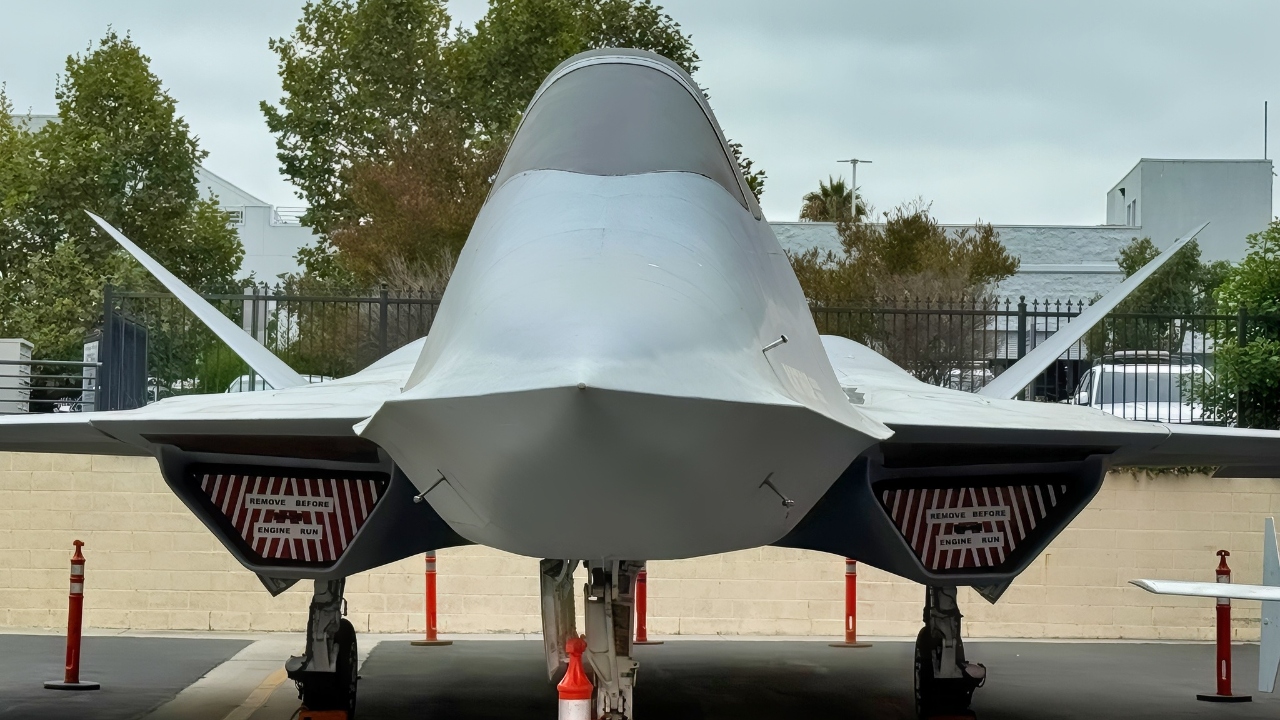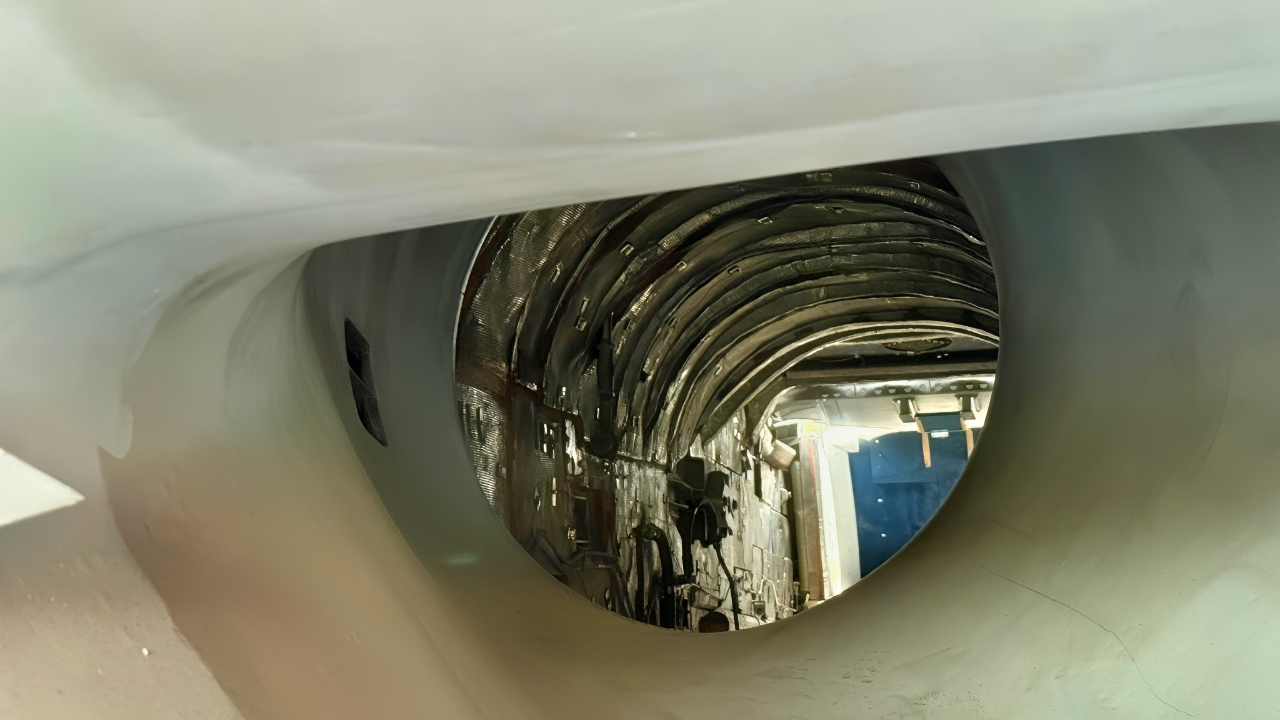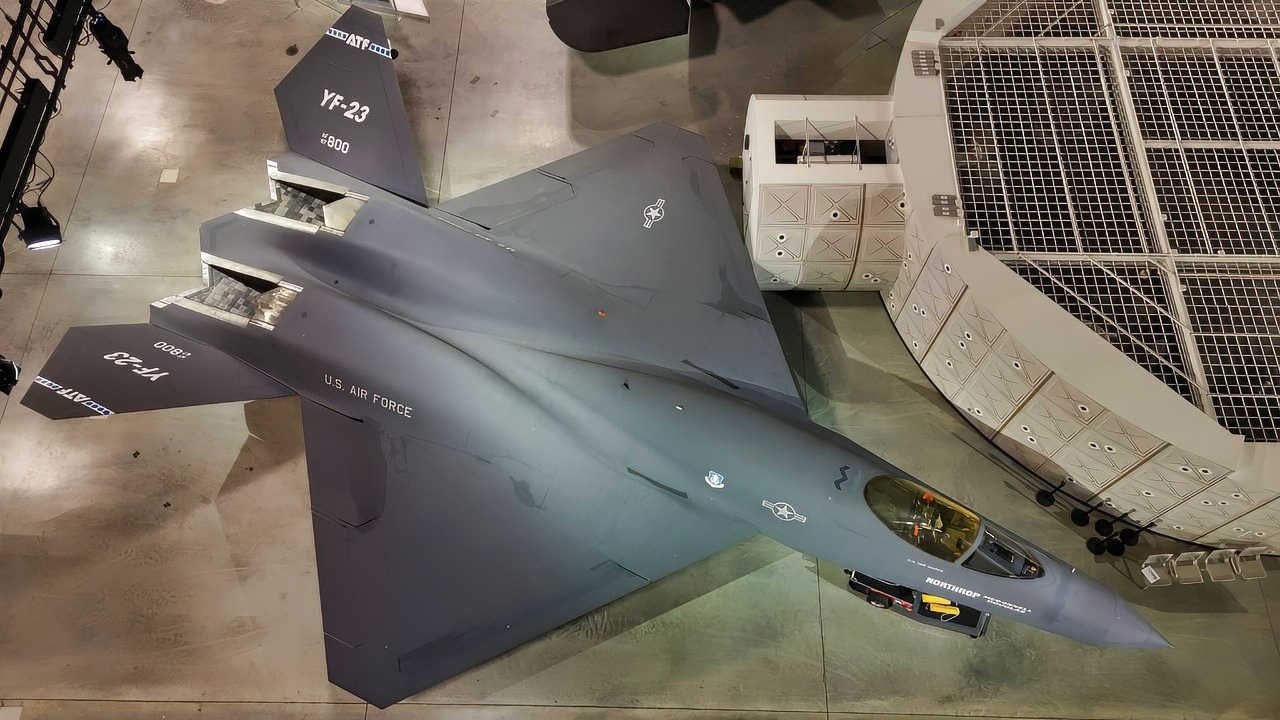Key Points and Summary – The YF-23 “Black Widow II” was a prototype stealth fighter that lost the Advanced Tactical Fighter competition to the F-22 Raptor.
-Many experts and pilots believe the YF-23 was the superior aircraft, boasting better all-aspect stealth, greater speed, and a longer range.

YF-23 National Security Journal Photo. Taken by Harry J. Kazianis at U.S. Air Force Museum on 7/19/2025.

YF-23 National Security Journal Photo. Taken by Harry J. Kazianis at U.S. Air Force Museum on 7/19/2025.
-It lost primarily because the Air Force, at the time, was still dominated by a “fighter mafia” that prioritized the YF-22’s superior dogfighting agility, which was enabled by thrust-vectoring.
-Poor “showmanship” from Northrop and a political desire to keep Lockheed Martin in the fighter business also contributed to the YF-23’s demise.
-The National Security Journal has spent countless hours visiting both YF-23 fighters still in existence. We present images and photos from those visits in this article.
How ‘Showmanship’ and the ‘Fighter Mafia’ Killed the YF-23
The YF-23, known as the Black Widow II, was a prototype stealth fighter developed by Northrop and McDonnell Douglas for the U.S. Air Force’s Advanced Tactical Fighter (ATF) program in the late 1980s and early 1990s.
Although it lost the competition to the YF-22 (which became the F-22 Raptor), the YF-23 was notable for its advanced stealth technology and unique design, featuring a blended wing-body configuration and canted vertical tails.
Northrop and McDonnell Douglas’ YF-23 was an outstanding aircraft and, in fact, was probably a better prototype than the Raptor. Still, it suffered from a lack of presentation to the program’s decision-makers.
Otherwise, history may have turned out quite differently. Considering how good an aircraft the Raptor is, that is saying something.
However, the Navy’s new F/A XX stealth fighter concept art was unveiled recently, and there has been near-universal agreement that it closely resembles the YF-23. Alex Hollings posted side-by-side pictures of the two aircraft, which seem pretty similar.

YF-23A Black Widow Outside. Taken by Harry J. Kazianis for National Security Journal on August 16, 2025.

YF-23A Side View Western Museum of Flight. Image by National Security Journal.
If the US Air Force had indeed selected the YF-23 over the Raptor, what impact would the Black Widow have had on the Air Force?
Meet The YF-23 Stealth Fighter:
The YF-23 had a sleek, stealthy design and innovative features; the Black Widow incorporated technologies like advanced radar-absorbing materials, a revolutionary diamond-shaped wing, and an emphasis on reduced infrared signatures.
It used a blended wing-body and S-duct engine intakes to reduce its radar cross-section.
The aircraft was powered by two Pratt & Whitney YF119 or General Electric YF120 engines, enabling supercruise. Having the supercruise capability meant it could maintain supersonic speeds without using fuel-guzzling afterburners, offering advantages in range and fuel efficiency.
The YF-23 could reach speeds of up to Mach 2.2 at high altitudes, flying over distances of 2,424 nautical miles (2,789 miles / 4,489 km), according to Aerotime Hub. Its combination of speed, agility, and stealth made it a fierce competitor.
While Lockheed’s YF-22 had a visually impressive design, the YF-23 truly stood out with its extraordinary appearance. It featured diamond-shaped wings that reduced radar visibility, and its slim side profile reminded one of the SR-71 Blackbird spy plane.

YF-23A Black Widow II Head On. Image Taken by National Security Journal at the Western Museum of Flight on August 16, 2025.

This photo was taken looking inside a YF-23A Black Widow II where the engine was removed. Photo: National Security Journal.

YF-23A Black Widow II National Security Journal Photo. Taken at the Western Museum of Flight by Harry J. Kazianis on August 16, 2025.
Why Did The YF-23 Lose to YF-22?
The YF-23 Black Widow was an aircraft ahead of its time, designed for incredible stealth. Its unique shape, angular surfaces, and blended edges were carefully crafted to minimize radar cross-section, ensuring reduced detectability by enemy radar systems.
The aircraft’s dark, radar-absorbent material coating further enhanced its stealth capabilities, absorbing and diffusing radar waves to prevent them from being reflected back to the source.
The YF-23 had better speed and stealth characteristics. The YF-23 also “showcased better range, higher ceiling,” one report stated after the competition. However, the aircraft lost the ATF competition to the YF-22, primarily due to the YF-22’s superior agility and maneuverability, which were considered more desirable for air combat. The thrust vector nozzles on the YF-22 made it a much more desirable dogfighter, and that ultimately won over the Air Force.
“What no one wants to admit is the ‘white-scarf, inside the furball’ fighter mafia still reigned supreme at that time,” according to test pilot Paul Metz, one of the few ever to fly both aircraft.
“Northrop’s YF-23 team was comprised of brilliant engineers,” he said. Metz added that the engineers were beyond compare, but he also recognized that they “thought and spoke almost exclusively in engineering terms.”
However, “Lockheed infused far more marketing, salesmanship, and pizazz—’ lasting impressions’ as he describes”—into their YF-22 flight demonstration program.
“They fundamentally understood how to sell their aircraft and how ‘showmanship’ heavily impacts the acquisition decision-making process. Northrop didn’t, and that fact may have proven fatal for the YF-23.”

YF-23 Black Widow II Up Close National Security Journal Photo.

YF-23 Black Widow II from National Security Journal Photo Shoot.
Was politics involved in the decision? Lockheed Martin’s track record with stealth aircraft, having developed the F-117 Nighthawk, was obviously an advantage. Its industrial team was larger and more experienced, and the company had strong relationships with key decision-makers in the Department of Defense.
At the time, Lockheed Martin lacked new fighter programs. The F-22 was a decision to keep them in the fighter business. Northrop had the B-2 project. The Air Force decided that it was essential to the country’s national security to keep Lockheed as an aircraft manufacturer and sided with the YF-22.
After the competition was completed, one of the two YF-23 prototypes was donated and is on display at the National Museum of the U.S. Air Force in Dayton, Ohio. We have visited that warplane and have photos from the visit in this article.
The “What If” Game Offers Many Opinions:
If the USAF had selected the YF-23, it would have led to a different but potentially similar outcome to the F-22 program, characterized by a fleet of advanced, expensive stealth fighters.
The YF-23 offered greater speed, range, and stealth, but was less maneuverable due to its lack of thrust vectoring and had a less mature design compared to the YF-22. This would have given the USAF a formidable, long-range stealth asset. However, the program would still likely have faced cost and operational challenges similar to those of the F-22, according to many aviation analysts.
One area that was overlooked at the time was that the YF-23 had significantly greater range than the F-22. This, when coupled with its better stealth profile, meant the YF-23 could fly further into contested airspace (where refueling isn’t an option) than its Lockheed competitor.
Today, that capability would be coveted among Navy officials as the branch continues to seek ways to extend the combat radius of carrier-borne fighters, especially in the Indo-Pacific, where Chinese A2/D2 defenses pose challenges for Navy aircraft in a future war.

YF-23 Black Widow II. Image Credit: USAF Museum.
Considering the F-22’s status as a fighter widely regarded as the most dominant air-superiority platform ever, and its continuous upgrades throughout its service life, it is fair to wonder how successful the YF-23 would have been, given its superior range and speed.
It may have been even more dominant, given how aircraft have evolved in modern air warfare. Many in today’s combat aviation (China included) believe that air combat increasingly emphasizes stealth and beyond-visual-range engagements over traditional dogfighting.
It is impossible to tell whether the problems that cropped up with the F-22 Raptor, resulting in billions of dollars in cost overruns, would have been alleviated with the YF-23. But having a stealthier aircraft with a longer combat radius is precisely what the Navy is looking for today… Isn’t it?
Perhaps the YF-23 will live on in the Navy’s F/A XX program. That would end the “what if” questions that persist today.
About the Author: Steve Balestrieri
Steve Balestrieri is a National Security Columnist. He served as a US Army Special Forces NCO and Warrant Officer. In addition to writing on defense, he covers the NFL for PatsFans.com and is a member of the Pro Football Writers of America (PFWA). His work was regularly featured in many military publications.
More Military
The Air Force Only Has 19 B-2 Spirit Stealth Bombers
Why the U.S. Navy Needs Lasers for an ‘Infinite Magazine’
U.S. Navy F/A-18 Super Hornet Fighter: How Hard Is It To Fly?
Unstoppable: Delta Force Is the Very Best Special Forces Unit on Planet Earth
Could a U.S. Navy Nuclear Aircraft Carrier Tip Over In a Storm?










